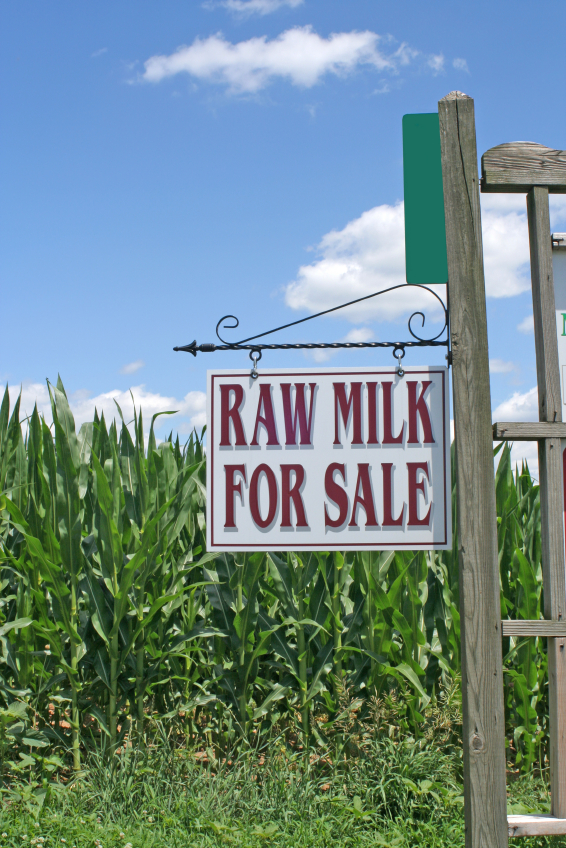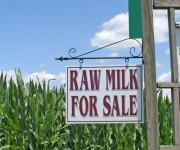Editor’s note: David Gumpert is the author of The Raw Milk Revolution: Behind America’s Emerging Battle over Food Rights and somewhat of an advocate for unpasteurized milk, sales of which are legal in some states and not in others. It is not a black and white (as milk) issue; we recommend swallowing as many facts around the possible risks and rewards as possible, starting here.
 Sign from a farm in Pennsylvania, where raw milk can be legally sold.Humboldt County in northern California has long been known as a mellow place, thanks in large measure to all the marijuana that’s grown there, legally and illegally.
Sign from a farm in Pennsylvania, where raw milk can be legally sold.Humboldt County in northern California has long been known as a mellow place, thanks in large measure to all the marijuana that’s grown there, legally and illegally.
But while Humboldt County may be the marijuana capital of America, it has no intention of becoming a mecca for another controversial natural product: raw milk.
Indeed, Humboldt County is having a very difficult time deciding whether to even allow the sale of unpasteurized milk, though decision time is rapidly approaching. On Tuesday evening, Jan. 11, the county’s Board of Supervisors is due to take up the issue — and it’s not at all clear what it will do.
California has the most permissive laws in the country with regard to distribution of raw milk — allowing not only raw milk, but other raw dairy products like butter, kefir, and cream to be sold via retail — but Humboldt County has long held to a local ban on raw milk sales. (About 20 states in the country also forbid it.)
The county’s ban is being challenged by the state’s largest raw milk producer, Organic Pastures Dairy Co., and its founder, Mark McAfee. Since Organic Pastures is prohibited from selling across state lines, it would like to expand the fast-growing California raw dairy market into Humboldt County.
McAfee made his pitch at a Board of Supervisors meeting last August, providing an array of articles and research suggesting that raw milk confers important health benefits on consumers. The five-member board decided to throw the hot potato into the lap of the county’s Department of Health and Human Services, asking it to study the matter and report back. Late last week, it issued its report [PDF], and while it makes no specific recommendations, the weight of its documentation is nearly completely negative for raw milk.
That’s because the Humboldt County public health reps sought input primarily from government agencies — which have long demonized raw milk as a public health menace. The FDA’s statement to the county says that it “continues to state that raw milk is inherently dangerous and should not be consumed directly … The FDA strongly encourages Humboldt County to continue to protect public health by prohibiting the production and sale of unpasteurized milk.”
Similarly, a Centers for Disease Control (CDC) official writes Humboldt officials that the Organic Pastures materials “do not change our position regarding the threat to public health posed by consuming raw milk because they do not comprehensively and objectively present the risks of infection with pathogens that may be present in raw milk. CDC supports regulations to restrict the sale of raw milk.”
Needless to say, McAfee isn’t pleased with the report. “Raw milk, as it is produced in California and sold into 400 stores and consumed by 50,000 people per week, is not given any credit for being clean and safe,” he states in an email response to Susan Buckley, director of the Humboldt County Department of Health and Human Services. “The idea that raw milk (as produced in California) is somehow ‘so dangerous,’ that it cannot be purchased by your citizens …. is an outrageous comment.”
He is especially upset about the dismissal by several of the government experts consulted by Humboldt County public health officials of a major 2007 European study of nearly 15,000 children concluding that “consumption of farm milk may offer protection against asthma and allergy.”
In its report to Humboldt County, the FDA takes issue with whether “farm milk” is the same as raw milk, since the study indicated that as many as half of the farm families boiled their milk. But while the European study’s authors advocated additional research to narrow down the specific factors underlying the reduced disease, the FDA expresses no such interest in doing so.
McAfee promises a petition drive to overturn the Humboldt County ban on raw milk if the Board of Supervisors won’t act. In his email to Buckley, he notes that Humboldt County has an active underground market in raw milk, which he sees as the public health threat, more than raw milk from licensed dairies, which have to meet strict pathogen guidelines. Moreover, he adds, “your Board of Supervisors has made marijuana a legal crop!!”
It is certainly remarkable, given all the discussion on this and many other food-related sites about the risks and benefits of raw milk, that positions remain as hardened as they do — to the extent that a county allowing marijuana has a problem with milk. Part of the problem seems to be the way the parties go at the issue. Trying to make the case for raw milk on the basis of its nutritional superiority to pasteurized milk, as Mark McAfee did, is a very difficult task, since there hasn’t been a lot of research, and what’s out there isn’t clearcut.
Trying to make the case that raw milk isn’t the public health hazard the FDA and CDC say it is — well, that is a different matter. Hundreds of thousands of people are drinking raw milk every day, without ill effect, in California and elsewhere. When you average CDC statistics showing 1,791 total illnesses from raw dairy, and 1,609 raw-milk illnesses over 33 years between 1973 and 2005, you get just 54 illnesses nationwide.
Yet the government position remains unyielding. Instead of examining ways consumers can be more effectively warned and educated about the possible dangers of raw milk, the experts continue trying to deny adults the right to make their own decision. So Humboldt County may continue to hold the distinction of being the one place in America where it’s easier to obtain marijuana than raw milk.



